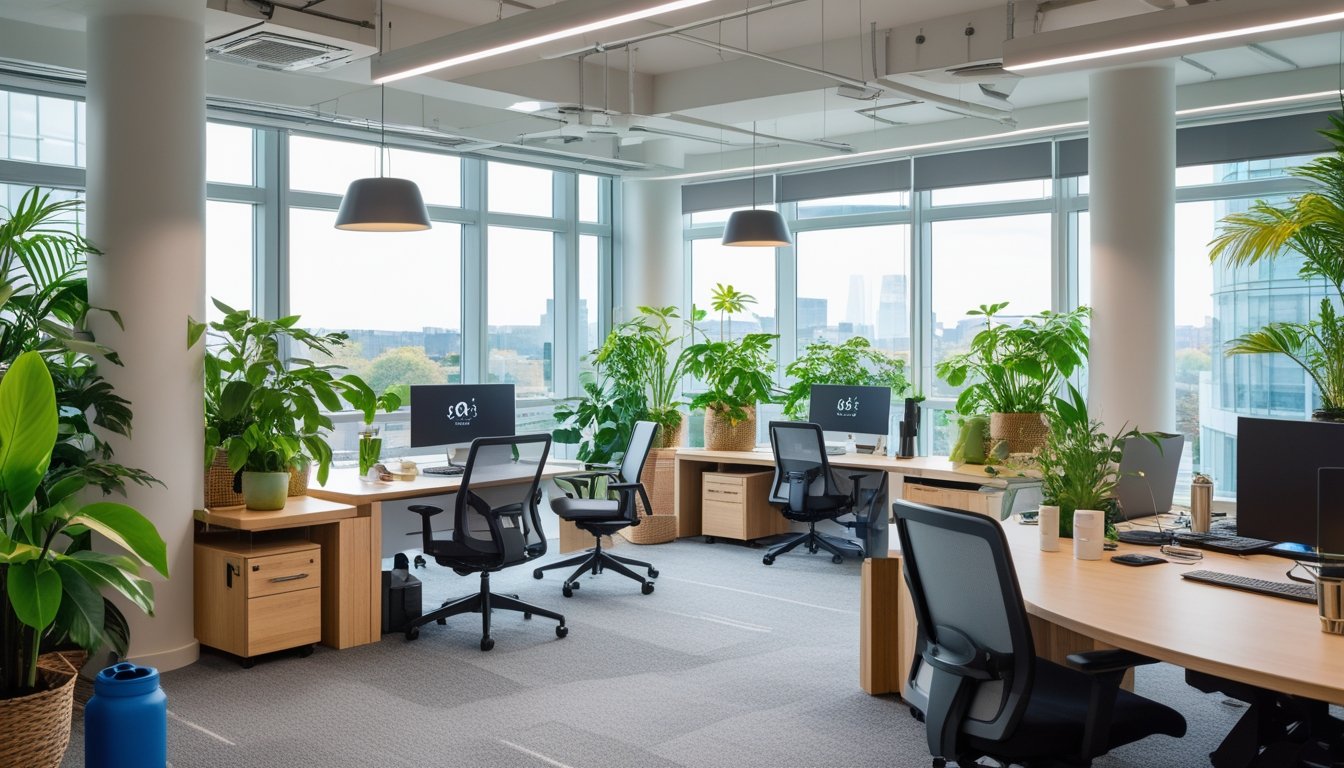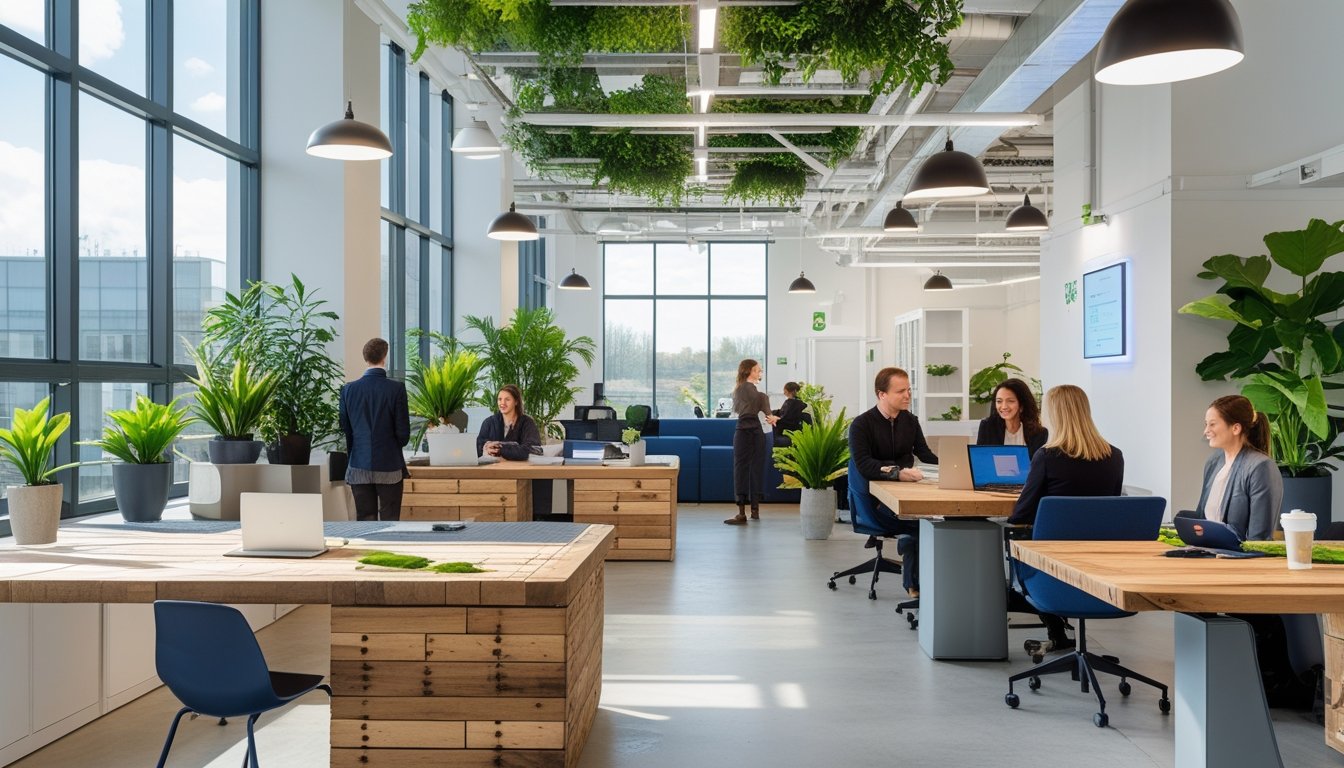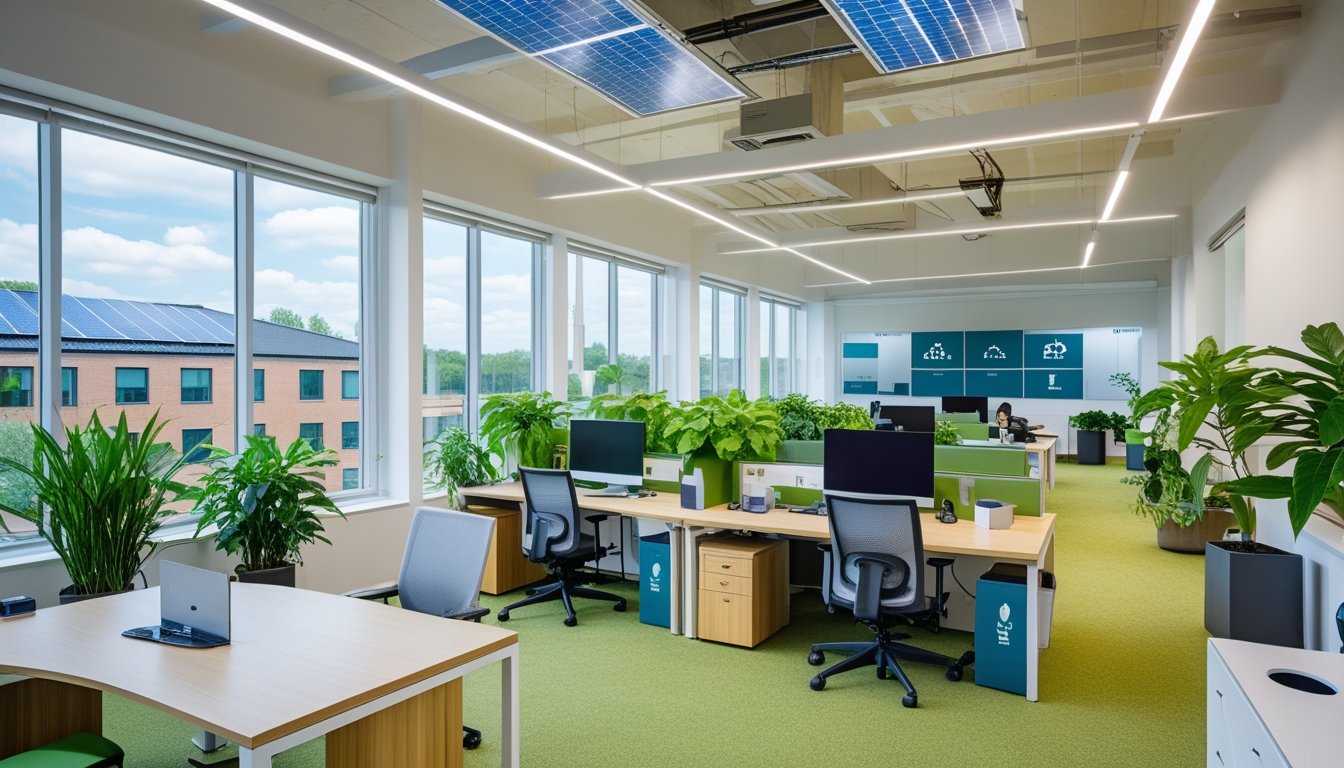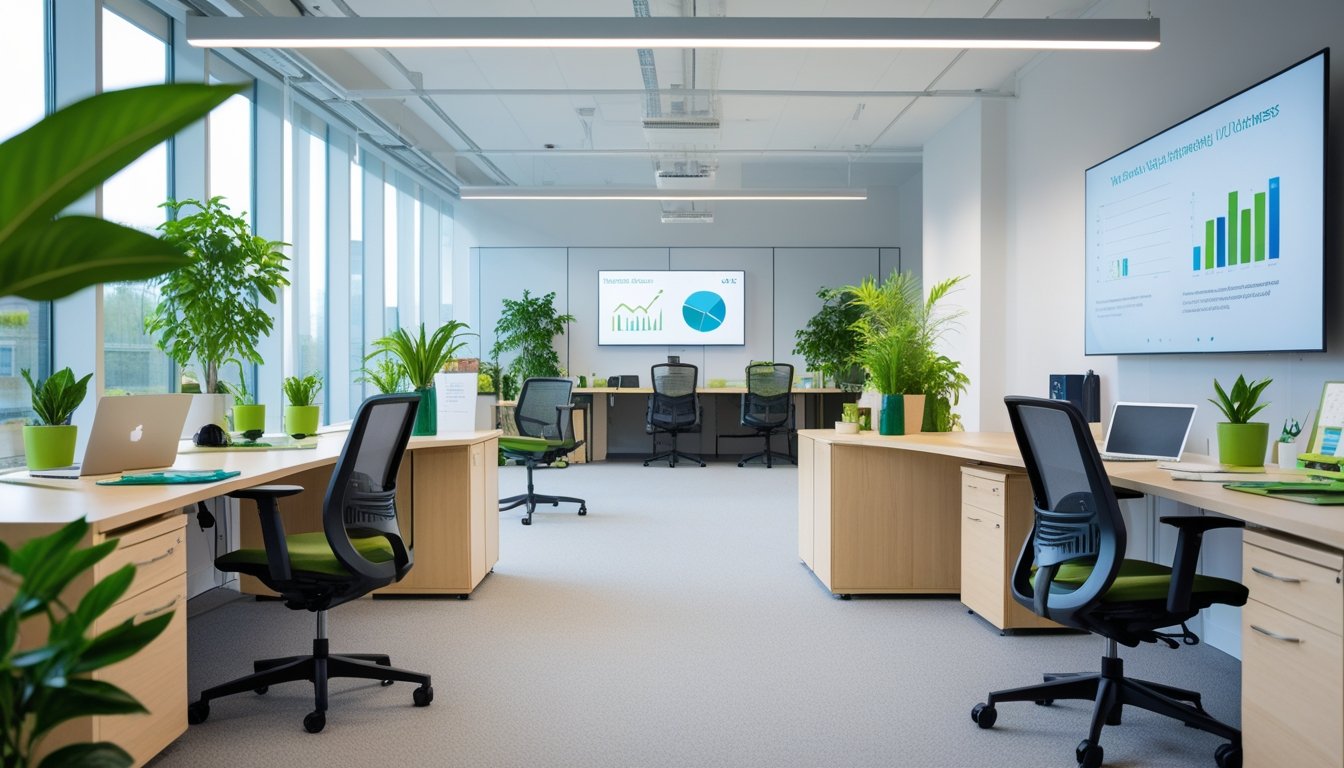Late updated: 12 May 2025 10:05
Written by: Amber Collins
Sustainable Office Design Ideas For UK Businesses: Enhance Eco-Friendly Workspaces
In today's rapidly evolving business landscape, integrating sustainability into office design is more crucial than ever for UK companies. As we prioritise eco-friendly practices, sustainable office design not only benefits the environment but also enhances employee well-being and reduces operational costs. Incorporating elements such as natural lighting, energy-efficient systems, and eco-friendly materials can transform office spaces into sustainable workspaces that foster productivity and creativity.

Creating a workspace that balances aesthetics and sustainability requires thoughtful planning and innovative solutions. From the use of vertical gardens and plant walls to harnessing renewable energy sources, the possibilities for designing a green office are vast and inviting. By investing in these sustainable practices, businesses can lead by example, showing their commitment to environmental responsibility while reaping the benefits of a healthier and more appealing work environment.
Key Takeaways
- Sustainable office design enhances both environmental and employee well-being.
- Innovative solutions like plant walls and natural lighting are vital.
- Embracing green practices reflects a commitment to sustainability.
Fundamental Principles of Sustainable Office Design

Sustainable office design focuses on achieving long-term environmental benefits while enhancing the workplace experience. By setting clear sustainability goals, focusing on reducing environmental impacts, and using recycled materials, businesses can create a positive change in their office spaces.
Setting Sustainability Goals
Setting sustainability goals is a crucial first step. These objectives guide the design process, ensuring every element aligns with broader environmental strategies. Clear goals may involve achieving net-zero carbon emissions or reducing a company's overall carbon footprint.
By defining specific and measurable targets, businesses can track their progress effectively. Establishing these objectives also demonstrates a commitment to tackling climate change and can enhance a company's reputation among stakeholders.
Reducing Environmental Impact
To reduce the environmental impact of office spaces, we focus on integrating energy-efficient systems. Lighting and HVAC innovations can significantly cut energy consumption. Implementing smart technology helps manage energy use more effectively, supporting our sustainability aims.
Another key strategy is water conservation. Systems like low-flow fixtures and rainwater harvesting contribute to more sustainable consumption. By reducing resource consumption, these approaches help decrease overall environmental impact.
Incorporating Recycled Materials
Using recycled materials in office design plays a pivotal role in sustainability. By sourcing materials with recycled content, we not only reduce waste but also cut down on the demand for virgin resources.
Furniture and architectural elements can be made from reclaimed wood, recycled metals, or sustainably sourced textiles. This practice not only lessens the building's environmental footprint but also supports a circular economy, where materials are reused and repurposed.
Incorporating such materials subtly communicates our commitment to sustainable practices while maintaining aesthetic appeal and functionality in the office environment.
Innovative Sustainable Office Design Ideas for UK Businesses

Our approach to sustainable office design focuses on energy-saving strategies, enhancing the workplace environment, and improving employee wellbeing. By integrating smart technologies and adaptive spaces, UK businesses can create a greener, healthier work setting that benefits both the employees and the organisation.
Improving Energy Efficiency
Energy efficiency is essential for sustainable office design. We can lower energy consumption by using LED lighting and energy-efficient HVAC systems. Installing programmable thermostats and energy management systems offers precise control over energy use, further reducing utility bills.
Another effective strategy is incorporating renewable energy sources. Solar panels can be installed on office rooftops, providing clean energy. These initiatives not only contribute to cost savings but also demonstrate a commitment to sustainability. By focusing on efficient energy use, we can create office environments that are both economically and environmentally friendly.
Harnessing Natural Light
Natural light dramatically improves the office atmosphere. We can maximise it by arranging the office layout to allow daylight penetration. Using glass partitions instead of opaque walls enables light to flow freely across the workspace.
Automated blinds and daylight sensors promote energy efficiency by optimising natural light. This not only reduces reliance on artificial lighting but also creates a pleasant office environment. Employees benefit from exposure to natural light, which can enhance mood and increase productivity. By prioritising natural light, we transform our office spaces into uplifting, vibrant environments that captivate the senses.
Enhancing Air Quality and Ventilation
Improving indoor air quality is a priority for sustainable offices. Using non-toxic paints and materials reduces the release of harmful chemicals. Advanced ventilation systems ensure a constant supply of fresh air, enhancing indoor air quality and reducing airborne pollutants.
Incorporating indoor plants is another effective measure. Plants naturally purify the air and contribute to a calming atmosphere. Maintaining high air quality is critical for employee health, helping to boost productivity and minimise sick days. As we focus on enhancing air quality, the workplace becomes a healthier and more productive setting for all.
Smart Technology Integration
Smart technology plays a pivotal role in sustainable office design. We can install energy management systems that monitor and reduce unnecessary energy usage. Smart lighting and HVAC systems can adjust based on occupancy, ensuring resources aren't wasted when spaces are unoccupied.
Incorporating smart technology improves not just energy consumption but also the workplace experience. It enables flexible, responsive environments that adapt to employees' needs, enhancing overall job satisfaction. As we integrate these technologies, we foster smarter, more efficient office spaces that cater to the evolving demands of modern workspaces.
Acoustic Solutions and Soundproofing
Noise pollution can significantly affect worker productivity and comfort. Effective soundproofing creates a more harmonious office environment. We can install acoustic panels that absorb sound and minimise distractions.
Designing dedicated quiet zones offers employees spaces to concentrate without interruption. Addressing acoustic issues contributes to a serene office atmosphere, enhancing concentration and overall job satisfaction. By prioritising soundproofing, we tailor our office spaces to be conducive to focus and efficiency.
Promoting Wellbeing and Employee Satisfaction
Employee wellbeing is central to sustainable office design. We provide ergonomic furniture to support healthy posture and reduce the risk of musculoskeletal issues. Spaces for relaxation and social interaction also contribute to a positive workplace experience.
Facilitating access to outdoor areas enables employees to recharge in nature, increasing satisfaction and productivity. Promoting employee health and satisfaction leads to higher retention rates and a more vibrant office culture. Our commitment to wellbeing enriches the workplace, making it inviting and supportive of all who enter.
Flexible and Adaptive Office Spaces
Flexibility in office design caters to diverse working styles. Modular furniture and moveable walls allow the space to adapt to changing needs. This flexibility is particularly relevant in the post-COVID-19 landscape, where hybrid work models are increasingly common.
Adaptive spaces accommodate varying team sizes and functions, enhancing collaboration without prolonged reconfiguration. By providing flexible spaces, we future-proof our offices against changes, creating dynamic environments that evolve with the organisation's needs. This adaptability positions us well to navigate the complexities of modern work, ensuring readiness for whatever challenges arise.
Frequently Asked Questions

Sustainable office design can significantly impact the environment and employee wellbeing. By implementing eco-friendly practices, integrating energy-saving technologies, and using sustainable materials, UK businesses can create efficient and supportive workspaces.
What are the best practices for creating an eco-friendly office environment in the UK?
Developing green policies and investing in sustainable technologies are crucial. Offices should incorporate renewable energy sources, such as solar panels, and ensure waste management systems are in place. Promoting recycling and reducing paper usage by going digital can further enhance sustainability.
How can UK businesses incorporate energy-saving features into their office design?
Energy-efficient lighting, like LED bulbs, and smart thermostats are practical choices. Motion sensors can reduce electricity consumption when spaces are not in use. Prioritising natural light through strategic window placement and skylights decreases dependency on artificial lighting.
What materials are recommended for a sustainable office refurbishment in the UK?
Eco-friendly materials such as FSC-certified wood, recycled metal, and furniture from renewable resources are advisable. Low VOC paints and finishes improve indoor air quality. Reusing existing furnishings or opting for second-hand items can also cut costs and reduce waste.
How can UK companies enhance employee wellbeing through green office spaces?
Green spaces with plants and access to outdoor views boost morale and productivity. Ergonomic furniture, combined with flexible workspaces, creates a comfortable environment. Offering wellness programmes and spaces dedicated to relaxation can further improve employee satisfaction.
What are the essential elements of a functional and sustainable home office?
A home office should utilise a comfortable, ergonomically designed workspace with sustainable furniture. Natural lighting is beneficial, and incorporating indoor plants can enhance air quality. Ensuring energy-efficient equipment and minimising resource consumption are key components.
What cost-effective strategies can UK businesses implement for a sustainable office design?
Conducting energy audits to identify inefficiencies and making incremental changes can be an economical approach. Sourcing locally produced materials and opting for modular office layouts that can be easily adapted can save money. Encouraging a shared-resource approach reduces expenses and fosters a sense of community.
